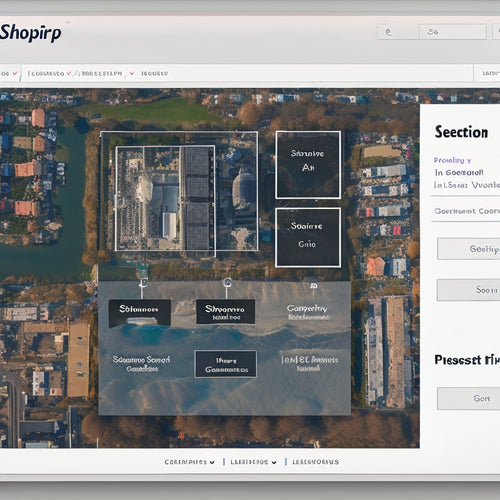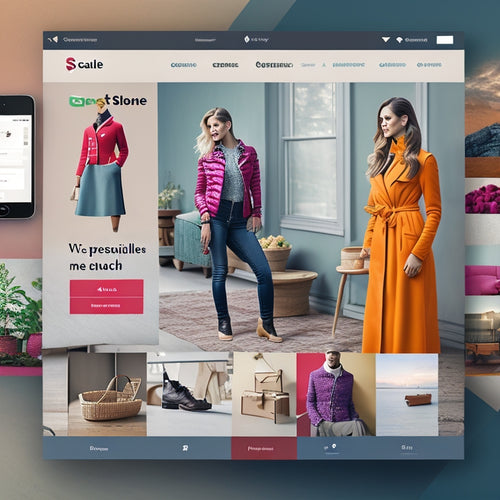
Revolutionize Your Online Store: Master Automation Techniques
Share
I'm taking my online store to the next level by mastering automation techniques that drive sales and customer satisfaction. I've got the basics covered, from setting up a Shopify store to outsourcing tasks like product uploading to a virtual assistant. Now, I'm focused on elevating the customer experience with personalized recommendations and real-time order tracking. I'm also leveraging dynamic retargeting ads and performance monitoring essentials to optimize my store's performance. By streamlining my operations and firing on all cylinders, I'm poised to revolutionize my online store - and I'm just getting started with tapping into its full potential.
Key Takeaways
• Establish a strong automation foundation by setting up a Shopify store, integrating dropship tools, and focusing on product sourcing and inventory management.
• Elevate customer experience through personalized recommendations, real-time order tracking, and convenient shipping options using integrated apps.
• Implement dynamic retargeting strategies using Facebook's Dynamic Product Ads to target customers who've interacted with the store and reduce cart abandonment rates.
• Monitor performance metrics such as traffic analysis, keyword optimization, and conversion rates to identify areas for improvement and make data-driven decisions.
• Scale success by dedicating time for search engine ranking, exploring SEO strategies, and driving traffic to promote winning products.
Setting Up Automation Foundations
As I begin constructing an automated eCommerce system, my first step is to establish a new Shopify store and connect GearBubble Dropship Integration for seamless and automatic order processing.
This integration enables me to concentrate on product sourcing, making certain that I can swiftly find and add new products to my store. Next, I assign product uploading to a virtual assistant (VA) to guarantee consistent addition of new products, enabling me to focus on inventory management.
With GearBubble, I can automatically manage my inventory levels, eliminating the risk of overselling or underselling products. This foundation sets the stage for a streamlined and efficient eCommerce system, providing me peace of mind and allowing me to focus on growth and optimization.
Elevating Customer Experience
How can I take my customer experience to the next level by leveraging the right apps and tools to drive engagement and loyalty?
By integrating apps like Best Currency Converter, Tracktor Order Tracking, and Free Shipping Bar, I can provide a seamless and personalized shopping experience for my customers.
These apps enable me to offer personalized recommendations, real-time order tracking, and convenient shipping options, resulting in higher customer satisfaction.
I can also use automated SEO apps to optimize product images, descriptions, and reviews, ensuring that my customers have access to accurate and up-to-date product information.
Dynamic Retargeting Strategies
I utilize Facebook's Dynamic Product Ads to retarget customers who've previously interacted with my online store, enabling me to re-engage potential buyers and drive conversions. This retargeting optimization strategy allows me to personalize ads based on users' browsing history, increasing the likelihood of conversion.
Through Facebook automation, I can create engaging ads that dynamically update product information, pricing, and availability in real-time. By setting up Dynamic Ads, I make certain that my target audience sees relevant products, reducing cart abandonment rates and boosting sales.
Performance Monitoring Essentials
What metrics are crucial to tracking when optimizing my online store's performance, and how do I leverage them to inform data-driven decisions that drive growth?
As I delve into performance monitoring essentials, I focus on traffic analysis to understand where my customers are coming from and what drives conversions.
I also prioritize keyword optimization, ensuring my product pages and ads are aligned with relevant search terms.
By regularly tracking metrics like bounce rates, conversion rates, and average order value, I can identify areas for improvement and make data-driven decisions to boost performance.
This granular approach helps me pinpoint opportunities to refine my marketing strategies, enhance the customer experience, and ultimately, drive revenue growth.
Scaling Success and Next Steps
With the establishment of an automated eCommerce system in place, dedicating time for the store to rank in search engines and explore various SEO strategies for better product page ranking is essential. Now, I'm focusing on scaling my success and outlining next steps.
I'll allow my store to climb the Google ranking ladder, fine-tuning my SEO enhancement techniques for best results. I'll also consider setting up Google Shopping Ads and Facebook Ads campaigns to drive more traffic and promote my winning products. By doing so, I'll secure a steady stream of customers and continued growth.
I'll keep a close eye on my store's performance, making data-driven decisions to stay ahead of the competition. With these strategies in place, I'm confident my online store will prosper.
Frequently Asked Questions
How Do I Handle Product Returns and Refunds in an Automated System?
I implement automated returns processing by integrating refund automation solutions, such as Returnly or Happy Returns, to streamline the returns process, ensuring timely refunds and minimizing manual intervention, while maintaining a secure and customer-friendly experience.
Can I Use Automation for Personalized Customer Communication and Support?
As I weave a personalized tapestry of customer care, I harness automation to segment my audience, crafting bespoke responses that whisper sweet nothings of understanding, making each customer feel seen and heard in a sea of digital noise.
Are There Any Automation Tools for Managing Inventory and Stock Levels?
"I utilize automated inventory tracking tools to monitor stock levels in real-time, ensuring accurate forecasting and preventing overselling or stockouts; I also set up low-stock alerts to proactively restock popular items."
How Often Should I Update and Refresh Automated Ad Campaigns for Better Results?
I regularly review and refresh my automated ad campaigns every 2-3 weeks to guarantee campaign optimization, updating targeting options, ad creatives, and bidding strategies to maximize ROI and avoid ad fatigue.
What Are Some Common Automation Mistakes to Avoid in Ecommerce Setup?
'Like a ticking time bomb, automation mistakes can explode into customer frustration; I avoid them by prioritizing customer feedback, monitoring shipping logistics, and regularly updating automation rules to prevent errors and guarantee a seamless shopping experience.'
Related Posts
-

Connecting Shopify and Pinterest: A Guide to Promoting Products
This article serves as a comprehensive guide to connecting Shopify and Pinterest for the purpose of promoting produc...
-

Adding Sitemap to Your Shopify Store: A Complete Guide
This article aims to provide a comprehensive guide on the process of adding a sitemap to a Shopify store. A sitemap ...
-

Expand Your Shopify Store With Top Sales Channel Apps
The integration of sales channel apps into the Shopify platform offers an opportunity for businesses to expand their...


